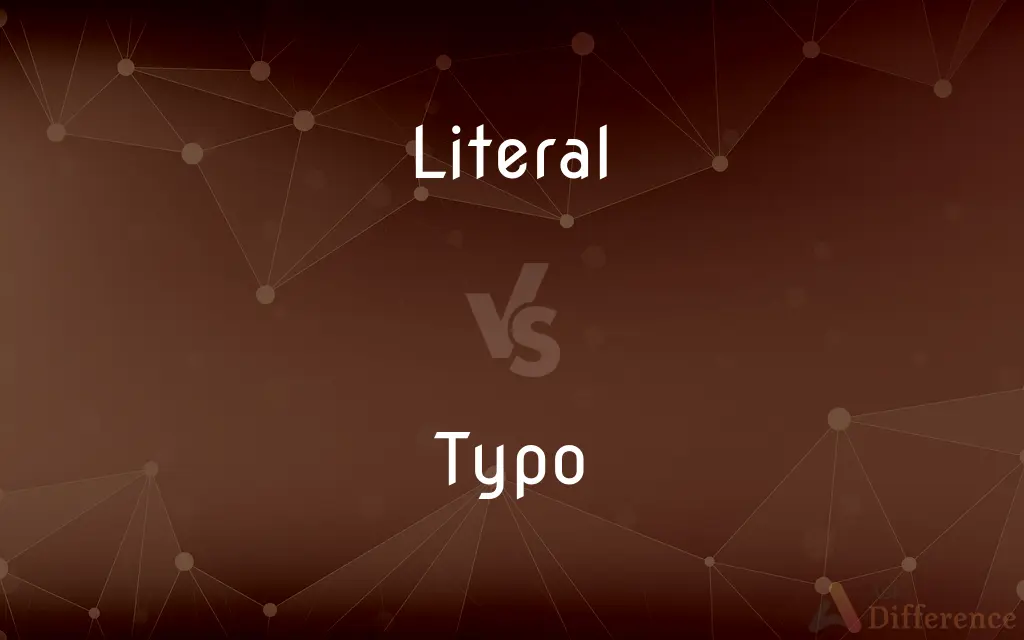Literal vs. Typo — What's the Difference?
By Tayyaba Rehman & Maham Liaqat — Updated on May 13, 2024
"Literal" pertains to the exact and primary meaning of words or texts, focusing on preciseness and adherence to fact; "typo" refers to a typographical error, an unintentional mistake made in typing or printing.

Difference Between Literal and Typo
Table of Contents
ADVERTISEMENT
Key Differences
"Literal" is used to describe the explicit, dictionary meaning of a word or phrase, emphasizing a straightforward interpretation without implying any underlying or symbolic meaning. On the other hand, "typo" specifically refers to a mistake made in the process of typing or printing text, such as misspelling a word or jumbling letters.
Literal interpretation is crucial in contexts where precision and clarity are necessary, such as legal documents or technical manuals. Whereas typos can occur in any text and usually represent a lapse in accuracy that needs correction to avoid miscommunication.
The term "literal" can also apply to translations or adaptations where the original meaning and context are maintained without embellishment or alteration. Conversely, a typo does not involve intentional changes but accidental errors that can sometimes alter the intended meaning of a text.
Employing a literal approach in language usage means adhering strictly to the true or factual meaning, often avoiding metaphorical or figurative language. In contrast, a typo is simply an error and does not reflect a deliberate stylistic choice in writing or presentation.
When discussing errors in communication, "literal" refers to errors of interpretation or understanding, particularly when someone fails to recognize figurative language. On the other hand, a typo is a mechanical error, typically easy to identify and correct with proofreading or editing tools.
ADVERTISEMENT
Comparison Chart
Definition
Relating to the exact meaning of words, strict adherence to fact.
An error in typing or printing, often involving misspelled words or mixed letters.
Context of Use
Important in legal, technical, and factual texts.
Occurs in any written material.
Implications
Ensures clarity and prevents ambiguity.
Can lead to misunderstanding if not corrected.
Nature
Intentional use of precise and direct language.
Unintentional error.
Correction Approach
Requires understanding and correct interpretation.
Typically corrected through proofreading or editing.
Compare with Definitions
Literal
Concerning the letters of a text.
His appreciation for the literal transcription of speeches is notable.
Typo
Usually a misspelling or transposition of letters.
Necessary was mistakenly typed as neccessary.
Literal
Not figurative or metaphorical.
The instructions must be understood in their literal sense.
Typo
Often minor but can change meanings.
A typo changed untied to united in the report.
Literal
Adhering to the strict, primary meaning of words.
She was literally freezing outside, meaning it was extremely cold.
Typo
An error made in printed or typed material.
The document was reprinted due to a typo on the front page.
Literal
In translation, adhering closely to the original text.
The literal translation of the document preserved the legal terminology.
Typo
Occurs accidentally during typing.
She corrected the typo in her email before sending it.
Literal
Conforming or limited to the simplest, nonfigurative, or most obvious meaning of a word or words.
Typo
Detected and corrected through proofreading.
The editor caught several typos during the review.
Literal
Word for word; verbatim
A literal translation.
Typo
A typographical error.
Literal
Avoiding exaggeration, metaphor, or embellishment; factual; prosaic
A literal description.
A literal mind.
Typo
A typographical error.
Sorry, I meant to say "buy a SODA" - "sofa" was a typo
Literal
Consisting of, using, or expressed by letters
Literal notation.
Typo
A compositor; a typographer.
Literal
A letter or symbol that stands for itself as opposed to a feature, function, or entity associated with it in a programming language
$ can be a symbol that refers to the end of a line, but as a literal, it is a dollar sign.
Typo
To make a typographical error.
Literal
Exactly as stated; read or understood without additional interpretation; according to the letter or verbal expression; real; not figurative or metaphorical, and etymonic rather than idiomatic.
The literal translation is "hands full of bananas" but it means "empty-handed".
Typo
A compositor.
Literal
Following the letter or exact words; not free; not taking liberties
A literal reading of the law would prohibit it, but that is clearly not the intent.
Typo
A typographical error; an error in typing, printing, etc.
Literal
(theology) (broadly) That which generally assumes that the plainest reading of a given scripture is correct but which allows for metaphor where context indicates it; (specifically) following the historical-grammatical method of biblical interpretation
Typo
A mistake in printed matter resulting from mechanical failures of some kind
Literal
(uncommon) Consisting of, or expressed by, letters (of an alphabet)
A literal equation
Literal
(of a person) Unimaginative; matter-of-fact
Literal
(proscribed) Used non-literally as an intensifier; see literally for usage notes.
Telemarketers are the literal worst.
Literal
A misprint (or occasionally a scribal error) that affects a letter.
Literal
(programming) A value, as opposed to an identifier, written into the source code of a computer program.
Literal
(logic) A propositional variable or the negation of a propositional variable. Wp
Literal
According to the letter or verbal expression; real; not figurative or metaphorical; as, the literal meaning of a phrase.
It hath but one simple literal sense whose light the owls can not abide.
Literal
Following the letter or exact words; not free.
A middle course between the rigor of literal translations and the liberty of paraphrasts.
Literal
Consisting of, or expressed by, letters.
The literal notation of numbers was known to Europeans before the ciphers.
Literal
Giving a strict or literal construction; unimaginative; matter-of-fact; - applied to persons.
Literal
Literal meaning.
Literal
A mistake in printed matter resulting from mechanical failures of some kind
Literal
Being or reflecting the essential or genuine character of something;
Her actual motive
A literal solitude like a desert
A genuine dilemma
Literal
Without interpretation or embellishment;
A literal translation of the scene before him
Literal
Limited to the explicit meaning of a word or text;
A literal translation
Literal
Lacking stylistic embellishment;
A literal description
Wrote good but plain prose
A plain unadorned account of the coronation
A forthright unembellished style
Literal
Of the clearest kind; usually used for emphasis;
It's the literal truth
A matter of investment, pure and simple
Literal
(of a translation) corresponding word for word with the original;
Literal translation of the article
An awkward word-for-word translation
Literal
Related to realistic or factual description.
His account of the events was quite literal.
Common Curiosities
How does a typo differ from other errors?
A typo specifically refers to errors made in typing or printing, like misspellings or misplaced letters, unlike errors of fact or judgment.
Is literal language preferable in all written communication?
Not always; while it's crucial in legal and technical texts, figurative language can enrich narrative and poetic texts.
What steps can be taken to avoid typos?
Regular proofreading, using spell check tools, and careful editing can help minimize typos in written material.
What is the significance of literal interpretation?
Literal interpretation ensures that the exact and intended meaning of words is conveyed, particularly important in precise or formal contexts.
Can a typo affect the understanding of a text?
Yes, typos can lead to misunderstandings if they significantly alter the words or context of the text.
Can typos be intentionally used for effect?
Yes, in some creative writing or advertising, typos might be used intentionally to attract attention or convey a particular message.
How does one correct a literal misunderstanding?
Clarification and education on figurative language and context can help address literal misunderstandings.
What are examples of situations where literal meanings are essential?
In contracts, legal documents, and safety instructions, where misinterpretation can have serious consequences.
What tools are effective in detecting typos?
Spell-checkers, grammar checking software, and human proofreaders are effective in detecting and correcting typos.
Why is it important to distinguish between literal and figurative language?
Understanding the difference helps in interpreting texts correctly, especially in diverse cultural or linguistic contexts.
Share Your Discovery

Previous Comparison
Stigma vs. Saffron
Next Comparison
Clot vs. ScabAuthor Spotlight
Written by
Tayyaba RehmanTayyaba Rehman is a distinguished writer, currently serving as a primary contributor to askdifference.com. As a researcher in semantics and etymology, Tayyaba's passion for the complexity of languages and their distinctions has found a perfect home on the platform. Tayyaba delves into the intricacies of language, distinguishing between commonly confused words and phrases, thereby providing clarity for readers worldwide.
Co-written by
Maham Liaqat












































